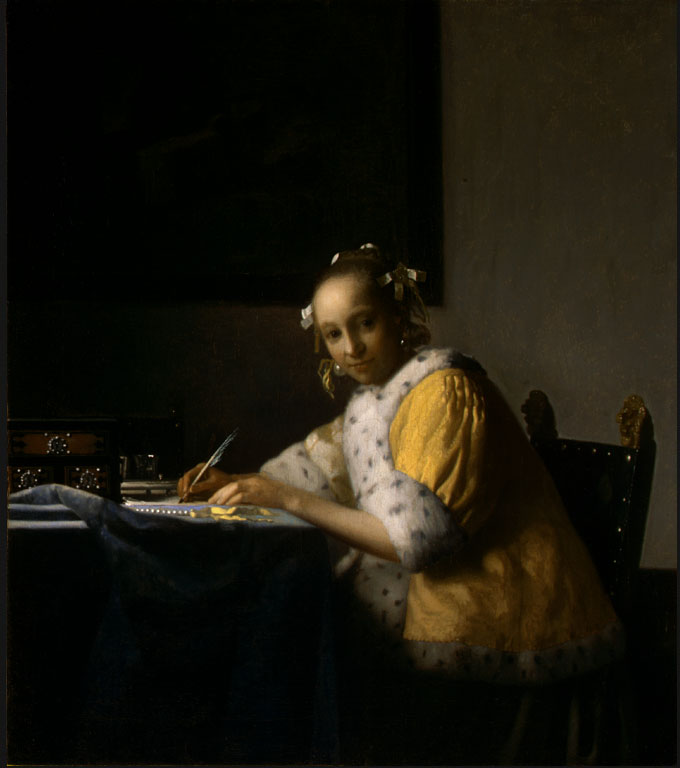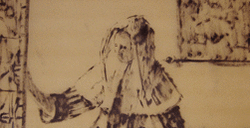Traces of Vermeer
An artist's detective story about the working methods of Johannes Vermeer
the creator of the Girl with a Pearl Earring
Johannes Vermeer (1632-1675) , A Lady Writing c. 1665-1667.
National Gallery of Art Washington
There is tremendous admiration, but also contention, about the work of Johannes Vermeer (1632-1675), because the experts cannot explain how he achieved his extraordinary, iconic images.
There is hardly a scrap of contemporary information about this most mysterious of painters: no letters or diaries, and no first hand descriptions of his working practice.
The biggest argument about how Vermeer's produced his luminous pictures is centred around his possible use of the camera obscura. We can see for ourselves direct parallels between his paintings, and those on our own phone cameras, in the distortions of scale, effects of light, and variable focus: connections observed as long ago as 1891 by the American artist and printmaker Joseph Pennell. Vermeer’s oeuvre lay unappreciated after his death, but it is possibly no coincidence that his work was rediscovered at about the time photography was beginning.
New research has uncovered links between Vermeer and a close neighbour of his, in the Catholic quarter of Delft, who may have possessed a box camera. However, this kind of equipment could not have provided Vermeer with a big enough tracing surface to have been much use.
However, an older system, the technology of the room camera , had been known for some time, and could have been use to project whole motifs on a wall or screen. It is quite possible that Vermeer to have heard about this, or even seen it demonstrated locally. All that was required was a convex lens, and a pair of curtains.
Suitable lenses were easily available in Delft. They were used to make flames ('burning glasses') and also in spectacles 'such as old people use'. There was a lens grinder and spectacle seller in Delft itself, and it is possible Vermeer may have seen pedlars, going from village to village, with trays of lenses. Curtains are listed in the inventory of Vermeer's possessions, and some appear in his pictures too.
While art historians have come round slowly to suggest that Vermeer must have known about the technology of the lens, they are very reluctant to address how he may have used a camera obscura in practice, insisting that he would have only observed optical effects, rather than tracing them, and using them directly in his paintings.
Yet it would have been possible for Vermeer to do so, as I demonstrate in my book, Traces of Vermeer
Practical experimentation in my own studio led me to find that tracings made in paint on oiled paper under a projection could be 'printed' onto a canvas using only the pressure of a hand. These printed images were slightly blurred, and gave an impression of strong illumination. They provided direct parallels with recent technical research, which showed rough brushstrokes in underlayers of Vermeer's paintings.
I believe that Vermeer could have used such prints to provide him with complete tonal compositions on the first painted layer of his canvas, which he never covered completely. These transfers, used as a base layer, would explain the variations in focus we see in his paintings, the lack of line, the luminosity, and the immediacy, and the blurred look of his pictures. The results answer a number of vexing questions about his techniques: in particular how he could have corrected the orientation of images from a camera obscura, and how he could have combined tracings made in a 'dark room' with a subsequent use of colour, and with the use of perspective.
Traces of Vermeer provides a new approach to this great painter's work, setting his studio in the context of his home surroundings in Delft. Hands-on experiments, using recipes from old ‘books of secrets’, are compared with the visual and scientific evidence of Vermeer’s own painting methods. I explain where artists found their raw materials and how they managed with a limited choice of colour and with unstable paint, and the use they made of some unlikely ingredients: the cochineal insect, madder root, buckthorn berry and sheep bones; the rainwater and rust. I explain how artists made their paintbrushes, ground their pigment and prepared their canvas, and how they constructed their paintings in time honoured tradition, layer by layer, bit by bit. I hear from travellers and scientists of the time, who tell us of the emerging interest in optics and its interconnection with alchemy, astrology and medicine.
I reveal just how Vermeer could have worked in an innovative way, without diminishing his genius, to trace images projected through a lens and transfer them to his canvas in the slow process of creating his masterpieces.
Vermeer kept his studio door tightly closed in his lifetime; maybe at last we can take a look inside, catch a glimpse of him at work, and uncover some of his secrets.
See more, and buy a copy of Traces of Vermeer
Hay on Wye Festival talk 2019. Podcast here
Exhibition in Washington 2022 and Amsterdam 2023
BBC Radio 4
'Dead Famous'
Tuesday March 5th 11.30 am
Hear me discuss the legacy of Vermeer with Rosie Millard
The original research paper, on which Traces of Vermeer is based, is free to download below:
| perception_to_paint__1_.pdf | |
| File Size: | 3579 kb |
| File Type: | |
Last updated February 2024

